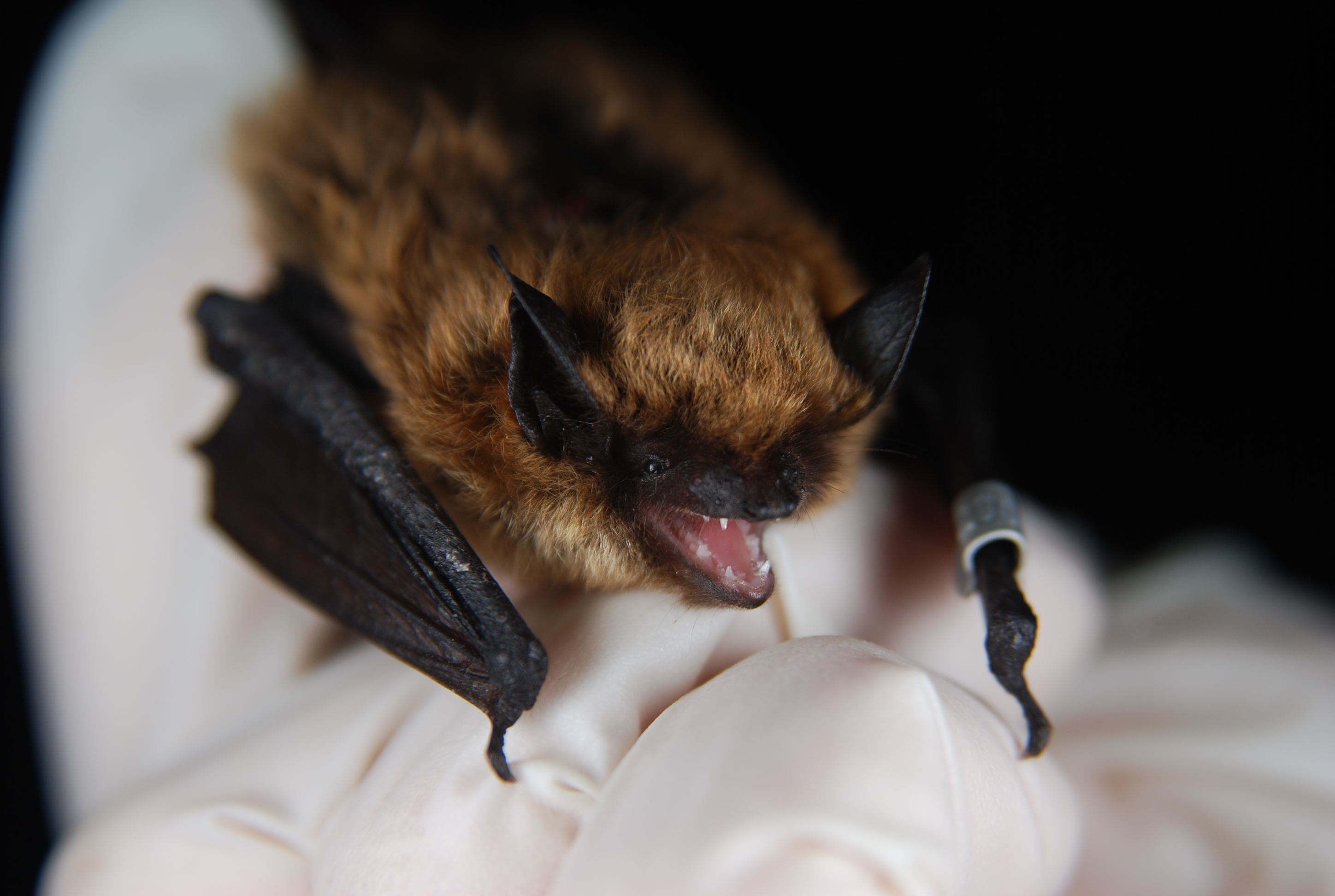Eastern Small-footed Myotis (Myotis leibii)

Key Takeaways
- Eastern Small-Footed Myotis is a bat species found in eastern regions of North America, primarily inhabiting forested areas such as deciduous and mixed hardwood forests.
- They have unique physical characteristics such as small feet for gripping surfaces, brownish-gray fur for camouflage, large round ears for echolocation, and elongated snout and sharp teeth for capturing insects.
- These bats have a diverse diet consisting primarily of insects and use aerial hawking and gleaning techniques to capture prey, with a particular affinity for beetles.
- The conservation status of Eastern Small-Footed Myotis is significant, as they are threatened by habitat loss and degradation, disturbance in roosting areas, white-nose syndrome, pesticide use, and climate change. Conservation efforts should focus on preserving habitats and migratory routes, studying reproductive strategies, and raising public awareness about the importance of bats.
Physical Characteristics
The Eastern Small-Footed Myotis (Myotis leibii) possesses distinct physical characteristics that contribute to its unique ecological adaptations. This small mammal is known for its diminutive size, with an average length of 3.1-3.9 inches and a wingspan ranging from 8.3-9.8 inches. Its most distinguishing feature is its small feet, which are adapted for gripping surfaces and enable it to navigate steep rock surfaces and cave walls with ease.
The Eastern Small-Footed Myotis is also recognized for its brownish-gray fur, which provides camouflage in its natural habitat. This species has large, round ears that aid in its echolocation abilities, allowing it to locate prey and navigate in the dark. Its elongated snout and sharp teeth are specialized for capturing and consuming insects, which make up the majority of its diet.
These physical adaptations play a crucial role in the behavioral adaptations and ecological role of the Eastern Small-Footed Myotis. Its ability to cling to surfaces and navigate complex cave systems allows it to access roosting sites that are inaccessible to other bats, providing an advantage in terms of safety and resource availability. Additionally, its efficient echolocation system enables it to detect and capture prey with precision, contributing to the overall balance of insect populations in its ecosystem. By understanding and conserving the physical characteristics of this species, we can better protect its ecological role in maintaining healthy ecosystems.
Habitat and Range
Eastern Small-Footed Myotis (Myotis leibii) can be found inhabiting a range that spans across the eastern United States. These small insectivorous bats have specific habitat preferences and exhibit unique migration patterns.
The Eastern Small-Footed Myotis primarily inhabits forested areas, including deciduous and mixed hardwood forests. They show a preference for roosting in caves, mines, and rock crevices, particularly those with moist and cool microclimates. These bats also utilize tree cavities and buildings as roosting sites, especially during the summer months. The availability of suitable roosting sites is crucial for their survival and reproduction.
Migration patterns of Eastern Small-Footed Myotis vary depending on their geographic location. In the northern parts of their range, they undergo seasonal migrations, moving to warmer areas in the south during the winter months. However, in the southern parts of their range, some individuals may exhibit a sedentary behavior and remain in their summer range throughout the year. Migration allows these bats to access more favorable climates and abundant food resources.
Understanding the habitat preferences and migration patterns of Eastern Small-Footed Myotis is essential for their conservation. Protecting and managing their preferred habitats, such as caves, forests, and roosting sites, is crucial to ensure their survival. Additionally, efforts should be made to minimize disturbances in their roosting areas and promote the conservation of their migratory routes. By adopting conservation strategies that consider these factors, we can help preserve the populations of Eastern Small-Footed Myotis and the important ecological role they play as insect predators.
Feeding Behavior
In terms of feeding behavior, Eastern Small-Footed Myotis display a diverse diet consisting primarily of insects. These bats are opportunistic foragers and employ a variety of foraging techniques to capture their prey. They are known to use aerial hawking, where they fly through the air and snatch insects on the wing. They also employ gleaning, where they pluck insects off vegetation or the ground. Additionally, Eastern Small-Footed Myotis are skilled at aerial hawking over water, catching insects that are attracted to the water’s surface.
Their dietary preferences are influenced by the abundance and availability of different insect species in their habitat. They have been observed feeding on beetles, flies, moths, mosquitoes, and other small insects. However, they have a particular affinity for beetles and are known to consume a significant number of these insects. This dietary diversity allows them to adapt to changes in insect populations and ensures their survival even in environments where certain prey species may be scarce.
Understanding the feeding behavior and dietary preferences of Eastern Small-Footed Myotis is crucial for their conservation. By studying their foraging techniques and monitoring their diet, researchers can gain insights into the health of their ecosystems. Conservation efforts can then focus on preserving the habitats and food sources that are essential for the survival of these bats.
Reproduction and Life Cycle
During the reproductive season, Eastern Small-Footed Myotis demonstrate mating behavior and engage in the formation of maternity colonies. Mating behavior in these bats is characterized by male competition for access to females. Males emit ultrasonic calls to attract females and establish territories. Once a male successfully mates with a female, she undergoes a gestation period of approximately 50-60 days. Eastern Small-Footed Myotis typically give birth to a single pup each year, usually in late May or early June.
Parental care is a crucial aspect of the Eastern Small-Footed Myotis’ reproductive strategy. The mother provides extensive care to her pup, including nursing, grooming, and protection. Pups are born with their eyes closed and rely heavily on their mother for nourishment and warmth. The mother produces milk rich in fat and protein, which ensures the pup’s growth and development.
The formation of maternity colonies is another important reproductive behavior exhibited by Eastern Small-Footed Myotis. These colonies consist of several female bats and their offspring. Maternity colonies provide a safe and communal environment where females can share responsibilities, such as pup-rearing and thermoregulation. These colonies also offer protection against predators and facilitate social interactions.
Understanding the mating behavior and parental care of Eastern Small-Footed Myotis is crucial for their conservation. By studying their reproductive strategies, scientists can identify potential threats to their survival and develop effective conservation measures to ensure their long-term persistence in their natural habitats.
Conservation Status
The conservation status of the Eastern Small-Footed Myotis is of significant concern due to various factors impacting their population and habitat. This species faces several threats that contribute to its decline.
- Loss of habitat: The destruction and fragmentation of forests, which serve as important roosting and foraging sites for the Eastern Small-Footed Myotis, have significantly reduced their available habitat. This loss of habitat limits their ability to find suitable shelter and food, leading to population decline.
- White-nose syndrome: This fungal disease has had devastating effects on bat populations across North America, including the Eastern Small-Footed Myotis. The disease disrupts their hibernation patterns, causing them to deplete their energy reserves and ultimately leading to death.
- Pesticide use: The Eastern Small-Footed Myotis, like other bat species, plays a crucial role in controlling insect populations. However, the use of pesticides can have detrimental effects on their health and survival, as they accumulate in their bodies and disrupt their reproductive and immune systems.
Conservation efforts are underway to protect and restore the Eastern Small-Footed Myotis population. These include:
- Habitat conservation: Efforts are being made to preserve and restore suitable forest habitats for the species, ensuring they have sufficient roosting and foraging areas.
- Disease monitoring and research: Scientists are actively studying white-nose syndrome to better understand its impact on bat populations and develop strategies to mitigate its effects.
- Public education: Raising awareness about the importance of bats and their conservation is crucial for their protection. Public outreach programs aim to dispel myths and promote understanding and appreciation for these valuable creatures.
Through a combination of habitat preservation, disease management, and public involvement, conservation efforts strive to reverse the decline of the Eastern Small-Footed Myotis and ensure the survival of this important bat species.
Bat Species
Rafinesque’s big-eared bat (Corynorhinus rafinesquii)
Silver-haired bat (Lasionycteris noctivagans)
Seminole bat (Lasiurus seminolus)
Little brown bat (Myotis lucifugus)
Indiana bat (Myotis sodalis)
Virginia big-eared bat (Corynorhinus townsendii virginianus)
Red bat (Lasiurus borealis)
Gray bat (Myotis grisescens)
Evening bat (Nycticeius humeralis)
Big brown bat (Eptesicus fuscus)
Hoary bat (Lasiurus cinereus)
Southeastern myotis (Myotis austroriparius)
Northern bat (Myotis septentrionalis)
Eastern pipistrelle (Pipistrellus subflavus)
Bat Related Diseases
Histoplasmosis
Rabies
White-Nose Syndrome
Nuisance Bat Topics
Frequently Asked Questions
What does an Eastern Small-Footed Myotis look like?
Eastern Small-Footed Myotis are among the smallest bats in eastern North America, known for their small feet and black face-mask. They have a relatively flat and short head, erect ears broad at the base, and a short flat nose. Their forearm length is less than 34 mm, and their tail length ranges from 25-45 millimeters. They are most likely to be confused with the little brown bat, especially in individuals where the face-mask is less apparent[2][3].
Where do Eastern Small-Footed Myotis live?
Eastern Small-Footed Myotis are found in the United States from New England to northern Georgia, and westward to northern Arkansas. They are commonly found in hilly or mountainous habitats and have been observed at elevations of up to 1,800 feet in the more southerly parts of their range[4].
What do Eastern Small-Footed Myotis eat?
Eastern Small-Footed Myotis prey on beetles and mosquitoes, which are pests to humans and agriculture. They play a role in controlling insect populations[3].
What is the conservation status of Eastern Small-Footed Myotis?
The Eastern Small-Footed Myotis is considered an endangered species. It has been observed that individual hibernacula have decreased due to factors such as the decline in mines, which has impacted their population[1][5].
Citations: [1] https://www.fs.usda.gov/Internet/FSE_DOCUMENTS/stelprdb5200543.pdf [2] https://animalia.bio/eastern-small-footed-myotis [3] https://www.biokids.umich.edu/critters/Myotis_leibii/ [4] https://www.biologicaldiversity.org/species/mammals/eastern_small-footed_bat/natural_history.html [5] https://www.catseyepest.com/library/wildlife/bats/eastern-small-footed-bat/
